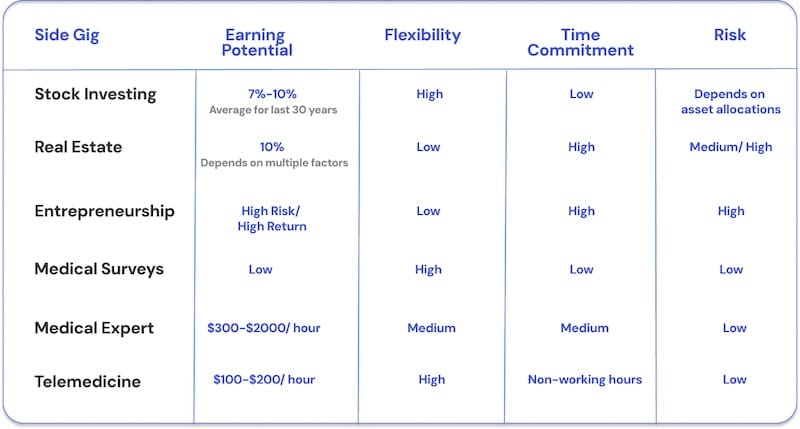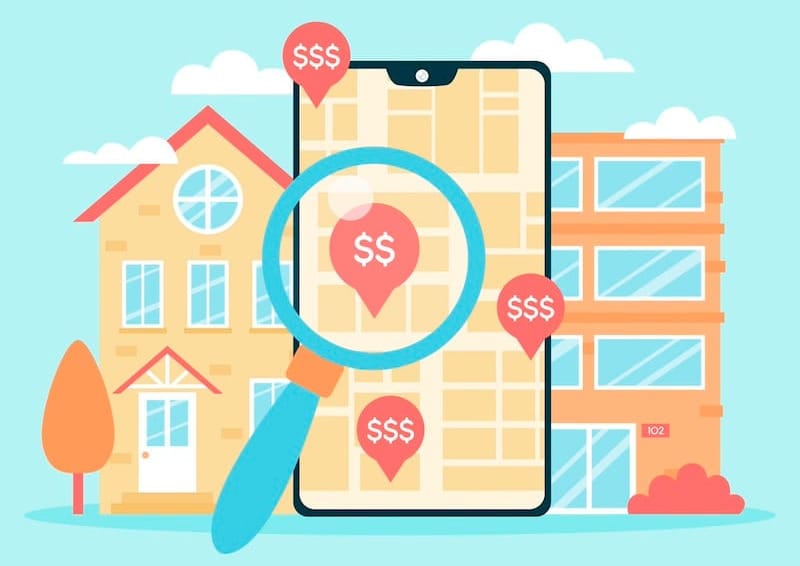Physician Side Gigs For Supplemental Income & Financial Independence

As a physician, you may find yourself looking to make supplemental income to pay off loans or build up a nice nest egg. Here are some options for side gigs for doctors and physicians. Some of these, such as investing or real estate, are not specific to the medical profession and do not require medical expertise. On the other hand, there are some side gigs that involve using your hard-earned medical expertise to earn some supplemental side income.

Benefits of Physician Side Hustles
First, let us start by trying to understand why having a side hustle may be an idea worth considering:
- Paying off student loans: If you have student loans from medical school, a side hustle can help pay some or all of your monthly student loan bills.
- Financial independence: If you were able to generate passive income via rentals, for example, you could achieve financial independence and possibly even retire early.
- Tap into your creativity through passion projects: One does not always get the chance to explore one’s passion in one’s day job. A side hustle could be a way for you to explore your creativity and test new ideas via entrepreneurship or consulting.
The Side Hustle Scorecard
We rate side hustles based on various factors below. You have to evaluate which option is right for you based on the following factors.
(1) Earning opportunity & Returns
(2) Interesting: Is the side-gig opportunity interesting to you?
(3) Flexibility: Is it flexible and does it fit in with your schedule easily?
(4) Time Commitment
(5) Risk
Important: Make sure you are in compliance with your workplace policy around part-time work or side hustles. You should get any permissions that may be needed from your organization to pursue these side-gig opportunities.
Most Common Physician Side-Gig Ideas
1.Investing
The most impactful side gig for doctors is investing in stocks, as it makes your money work for you 24/7 and offers the potential for long-term financial growth and passive income.
Passive Investing
Passive investing is a long-term buy-and hold strategy with the aim to match stock market index returns. Passive investors typically buy index funds or ETFs and follow a Dollar Cost Averaging (DCA) strategy to regularly take money from your paycheck and invest in market index funds. This DCA approach enables disciplined savings and smooths out market fluctuations. It is important to periodically balance your portfolio to achieve the right asset allocation based on your age and risk profile. This ensures that you can take advantage of stock appreciation while not spending much time on actively managing your investments. The Boglehead investing approach strongly favors passive investing to lower fees and transaction costs.
Who this is for
- Passive investing is for everyone and especially useful for people with less time on their hands and very busy schedules.
- Even if you are a busy physician with no time to research stocks or do not have a lot of expertise in investing, you can successfully follow a passive investment approach.
Scorecard
- Earning potential: 7% - 10% annual returns on average in the last 30 years.
- Flexibility: High.
- Time Commitment: Low
- Risk: Matches risk of standard S&P index
Active investing
Active investing requires you to be hands-on and do your research thoroughly and buy stocks that have the potential to outperform the stock market. It requires a lot of time commitment to investigate and research stocks.
Who this is for
- Active investing is for people who have interest in researching stocks or doing technical analysis.
- Active investors need to spend more time and make sure they are on top of market movements.
Scorecard
- Earning potential: 7% to 10% annual returns on average in the last 30 years, but higher fees than passive investing.
- Flexibility: Medium - requires you to spend time on research
- Time Commitment: High
- Risk: High,
2.Real estate investing
Real estate can be a good way to generate passive rental income and helps build wealth in the long term through property appreciation. Real estate income can supplement one’s regular income or help you achieve an earlier retirement.
You can put your rental property on Airbnb or other short-term rental platforms such as Vrbo. But first make sure you are aware of your city and neighborhood policies around short-term rentals.
House hacking is also a way that you can reduce expenses by generating rental income from your home or property while living in it. You can rent out part of your home while living in it or renting out multiple units of a multi-family home while living in one of the units. This can pay for some of your mortgage or real estate investment costs.
However, it is important to note that real estate investing can take up a lot of time, at least in the initial stages when you have to do your research to buy the rental property. If the property needs remodeling and work, this can be a huge time sink. So doctors and physicians who already have very busy careers should think about whether this is something they have the time and interest for doing.
Before you invest money in real estate, you need do your homework on the following aspects:
1. Crunch the numbers and calculate important metrics such as Net Operating Income, Return on Investment (ROI) and Internal Rate of Return (IRR), Estimate the Breakeven Rent needed on the rental property.
2. If you have student loans, you need to determine whether it makes more sense to pay down loans first or invest in real estate.
Who this is for
- Physicians who have the time and expertise to research real estate property.
- People who can potentially allocate time for managing the rental property. Some properties may require remodeling or other work, so make sure you know what you are signing up for when evaluating rental properties.
Scorecard
- Earning potential: It depends on rental income, property-related expenses & appreciation.
- Flexibility: Low
- Time Commitment: High
- Risk: Medium to High
3.Healthcare Entrepreneurship & Startups
Have you ever thought that you could apply your specialized medical knowledge to become an entrepreneur? Maybe you have a great idea for a telemedicine product, a patient messaging app or clinical note-taking apps. Or you want to use AI to analyze large datasets to find and diagnose diseases.
So how can you get started? Here are a few ways:
- Start by working part-time or consulting for an existing health care app: Many startups are in need of domain knowledge and you can get your feet wet and determine if this is something you want to pursue in the longer term.
- Become CMO (Chief medical officer) for a healthcare company or startup: I have known entrepreneurial-minded doctors who found a rewarding startup career by becoming CMOs for healthcare startups. They partnered with tech founders to drive the strategy and direction for healthcare startups.
- Try a service like Y Combinator co founder dating: If you have an idea for a healthcare digital product, you can go to YCombinator Cofounder dating to find technical or business co founders to bring your idea to reality. The Y Combinator Startup School also offers content to learn about how to get going on your startup idea.
Who this is for
- Startups & entrepreneurship are a good fit for those with an entrepreneurial mindset.
- You have to be prepared to spend a lot of evenings and weekends initially to validate your idea.
- You have to be comfortable with risk.
Scorecard
- Earning potential: High risk/ high return. Depends on whether the venture is successful.
- Flexibility: Low
- Time Commitment: High
- Risk: Medium to High
4.Medical surveys
Pharmaceutical or research companies doing market research want qualitative or quantitative feedback from doctors and will often do paid surveys to get doctors’ opinions. Platforms such as Sermo make it easier for doctors to easily sign up to take surveys. It is estimated that doctors can earn up to $15,000 per year, although that is very much on the higher side and most doctors will earn far less.
The medical survey side hustle can be done on one’s own schedule and you can dial it up or down as needed. However, the frequency with which you get survey opportunities depends on your specialty as a doctor.
According to Physician side gigs, the most in-demand specialties are hematology oncology, neurology, rheumatology, gastroenterology, pulmonary specialty, surgeons and cardiologists.
The compensation is variable, with some physicians making as much as $10K to 15K per year, and others not making much at all.
How to get started
You can sign up on platforms such as Sermo, curizon, E-Rewards Medical, Brand Institute, M3 Global Research, All Global Circle, m-Panel, Opinionsite, Incrowd, Zoom Rx.
Who this is for
- Any doctor willing to share their feedback or expertise.
- Medical surveys will not provide a huge chunk of income for most doctors, but can be a nice supplementary income for less effort.
Scorecard
- Earning potential: Low, but can be a nice supplement
- Flexibility: High
- Time Commitment: Low
- Risk: Low
5.Medical Expert witness
A medical expert witness can make $300-$2000 per hour to provide medical opinions in legal proceedings or court cases. The nature of work may range from court testimonies to creating documentation or advising attorneys on medical aspects of legal cases. The cases typically are personal injury or medical malpractice cases although sometimes you could find yourself providing testimony in a criminal case.
So how can you set about being a medical witness? You can start by networking with attorneys. Sign up with Medical Board of California, Arrowhead Evaluation Services (AES) or Expert Institute
You can also use this expert witness fee calculator to find out how much you can potentially make:
Scorecard
- Earning potential: High, but opportunities can be sporadic.
- Flexibility: Medium; Court dates can move frequently and interfere with your doctor duties.
- Time Commitment: Medium, depending on court dates
- Risk: Low
6.Telemedicine
With the advent of Zoom and other remote technology solutions, you can offer telemedicine services from the convenience of your own home during non-working hours. You can sign up as a contractor through telemedicine companies and make a nice side income. Hourly rate can be from $100- $200 per session.
You can look at platforms such as Teladoc or Doctors on Demand to get started.
Scorecard
- Earning potential: Medium, depending on whether you find the right telemedicine opportunity
- Flexibility: High
- Time Commitment: Medium (Non-working hours)
- Risk: Low
At Planwell, we are building a fully automated AI financial planner and advisor to help doctors and medical professionals make super personalized financial decisions such as how to retire early and achieve financial independence & how much house you can afford, while considering your lifestyle, retirement goals and other key factors.
We will be launching the product very soon. Stay tuned for an update. In the meantime, check out our blog posts to help you plan your finances.
- Financial Planning Strategies for Doctors & Medical Professionals
- Backdoor Roth IRA Process: Learn more about the backdoor Roth IRA process.
- 5 Overlooked Workplace Benefits: Lesser known workplace benefits that can be super useful and help save a lot of money.
- How to build a personal financial plan: Build your personalized financial plan with our 10 step guide.
- How to Use AI Budget Calculators and Tools to Plan Your Finances: Take advantage of our free FIRE calculator to plan your finances more effectively.
Related Posts
About
©2023 Planwell.io



